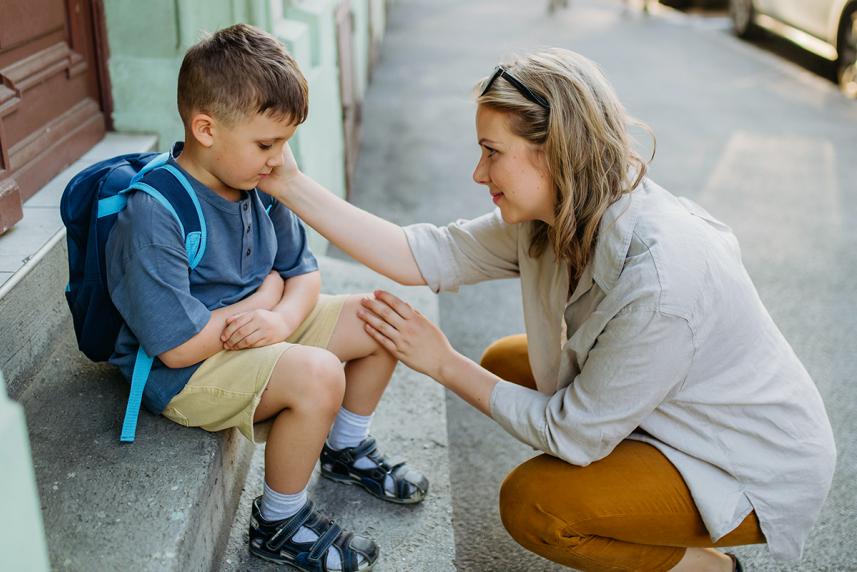
Work with a therapist through one of Refresh Mental Health’s centers, now offering virtual care and services at more than 300 places nationwide.

It can be distressing when someone picks on your kid in school. Luckily, there are ways to help protect and empower them.
It’s easy to find the school bully in classic teen movies. They’re often the kid who’s pinning other kids against a locker and stealing their lunch money.
Physical bullying does still happen in schools. But other forms of bullying may not be as easy to notice. And the problem is very real.
Around 1 in 5 students between the ages of 12 and 18 have reported being bullied in school.1 Bullying is most common in middle school, followed by high school, according to the Centers for Disease Control and Prevention.2
Kids who are picked on may feel anxious or depressed, have trouble sleeping and more.2 But they are often afraid to talk about it with their families.
That’s why it’s important for parents to understand what bullying is and know how to talk to their children about it.
One of the first things to understand about bullying: It’s not the same as healthy conflict, says Tori Cordiano, PhD. She is a licensed clinical psychologist in Beachwood, Ohio, and the director of research at Laurel School’s Center for Research on Girls.
“Lots of things get called bullying that are actually just conflict,” she says. Conflict is difficult and hard for kids to manage. But it’s also a normal part of growing up.
Cordiano explains that conflict can happen when kids:
Bullying behavior is different.2 It is defined by:

Work with a therapist through one of Refresh Mental Health’s centers, now offering virtual care and services at more than 300 places nationwide.
There are a few different types of bullying. Some happen more often than others. But each kind can be difficult for children.
Verbal harassment: Teasing. Mean comments. Being made fun of. These are all forms of verbal bullying in schools. One of the most common is name-calling, says Nekeshia Hammond, PsyD. She’s a licensed clinical psychologist in Brandon, Florida. Other forms of verbal bullying include:
Social harassment: Social bullying is more common among girls.6 But it can affect both boys and girls. It can include:
Physical bullying: This type of bullying causes physical pain. According to the American Academy of Pediatrics, it can involve:6
Cyberbullying: Your teen probably spends plenty of time on their phone. Cyberbullying happens when people post or share negative, harmful, false or mean content or photos using a digital device.7 That might include sharing personal or private information. Or with the intent to cause them embarrassment or humiliation. And cyberbullying can happen anywhere digital: via text messages, social media posts, apps, direct messaging, gaming forums and more. And it can happen at any time of the day or night, not just at school.
Maybe your child has told you that they’re being bullied in school. Or maybe you just suspect that something might be going on. Some red flags to look out for include:6
According to stopbullying.org, red flags specific to cyberbullying include:8
“This is the kind of challenge that we want to make sure kids know we don’t expect them to handle all on their own,” says Hammond. “That’s sort of above their pay grade as just children to be able to solve that.”
It’s also worth reminding your child: because someone says something negative about you, it doesn’t make it true, says Hammond.
Kids may just watch when they see bullying happening at school, if they are not sure what to do. Teach kids about being an “upstander” instead of a “bystander,” suggests Cordiano.
But it can be hard for children and teens to act in the moment, she says. That’s why it’s important to teach kids what to do ahead of time. They can:
So go ahead. Start the conversation about bullying with your child today. And bring it up often. It’s important for kids to realize that they can take action, and that you’ll be there for them every step of the way.
Sources
© 2024 Optum, Inc. All rights reserved. Do not reproduce, transmit or modify any information or content on this website in any form or by any means without the express written permission of Optum.
The information featured in this site is general in nature. The site provides health information designed to complement your personal health management. It does not provide medical advice or health services and is not meant to replace professional advice or imply coverage of specific clinical services or products. The inclusion of links to other web sites does not imply any endorsement of the material on such websites.
Optum does not recommend or endorse any treatment or medications, specific or otherwise. The information provided is for educational purposes only and is not meant to provide medical advice or otherwise replace professional advice. Consult with your clinician, physician or mental health care provider for specific health care needs, treatment or medications. Certain treatments may not be included in your insurance benefits. Check your health plan regarding your coverage of services.
If you or someone you know is in crisis— seek safety and get help right away. If you or someone you know is in immediate danger, call 911 or go to the closest emergency room.
To reach a trained crisis counselor, call the 988 Suicide & Crisis Lifeline (previously known as the National Suicide Prevention Lifeline) at 988 or 1-800-273-TALK (1-800-273-8255). You may also text 988 or chat at 988lifeline.org. The lifeline provides 24/7 free and confidential support.
Stock photo. Posed by model.